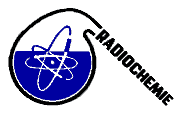Speaker
Nils Baumann
(FZD)
Description
Nils Baumann*, Thuro Arnold
Forschungszentrum Dresden-Rossendorf e. V., Institute of Radiochemistry, P.O. Box 510119, D-01314 Dresden, Germany
*Tel.: +49 (351) 260 2076, Fax: +49 (351) 260 3553, Email: n.baumann@fzd.de
The test field “Gessenwiese” was installed on a leaching heap at the former uranium mining area Ronneburg (western Thuringia) for investigations in acid mining drainage and in heavy metals retention, especially uranium (Grawunder A. et al. 2009). The uranium speciation in seepage water of the Gessenwiese was determined by TRLFS. Time-resolved laser-induced fluorescence spectroscopy (TRLFS) posses some superior features, above all a very high sensitivity for fluorescent heavy metal ions. The predominance of TRLFS compared to other spectroscopic techniques, e.g. XRD and IR was showed in Baumann N. et al. (2008) in analyzing the speciation of U(VI) in a thin layer of an alteration product formed on depleted uranium.
TRLFS analyses were carried out to compare it in a later stage with the uranium speciation in plants, which grow on that grassland and may take up uranium contaminated water. The uranium content in the seepage water sam-ples was 75.1 and 291 ppb, respectively, and both samples delivered an evaluable fluorescence signal for TRLFS. The positions of the six peak maxima from these signals are in both water samples in concordance with data for uranium sulfate species published in the literature, e. g. in Geipel G. et al. (1996) at 477, 493, 513, 537, 562 and 591 nm. Moreover, the time-resolved fluorescence signals of both water samples possess a mono-exponential decay, indicating the presence of one main species. These two characteristics, i.e. positions of peak maxima and lifetimes revealed without doubt that the uranium speciation in the seepage water is dominated by uranium (VI) sulfate species.
TRLFS measurements with plant compartments (e.g. roots, leaves, shoots) which grow in association with the seepage water will be carried out in future investigations. Samples could be obtained from the plant compart-ments by centrifugation as cell sap, or as solid milled plant compartment sample and subsequently analysed by TRLFS. The reactivity and toxicity of uranium depend on the speciation of heavy metals (Carrière et al. 2005) and accordingly have to be considered as important possible risk factor as uranium may enter economic plants and eventually arrives in the food chain.
Grawunder A. et al. Chem Erde-Geochem. 69 5-19 (2009)
Baumann N. et al. Environ. Sci. Technol. 42 8266-8269 (2008)
Geipel G. et al. Radiochim. Acta 75 199-204 (1996)
Carrière M. et al. Nucl. Instrum. Methods Phys. Res. Sect. B-Beam Interact. Mater. Atoms 231, 268-273 (2005)
Primary author
Nils Baumann
(FZD)
Co-author
Thuro Arnold
(FZD)

